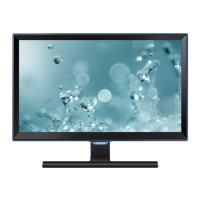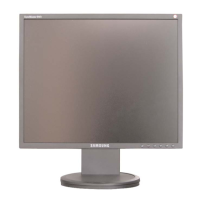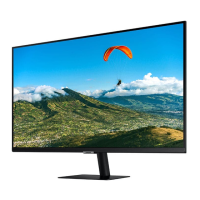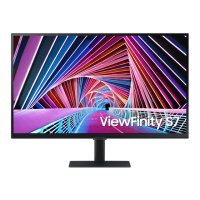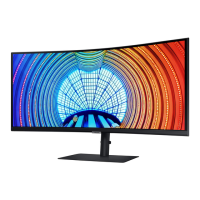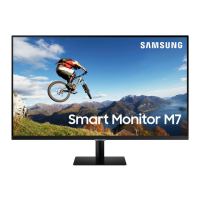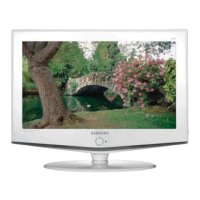Why is the power LED off and the screen won't switch on for my Samsung Monitor?
- AAmanda CopelandJul 31, 2025
If the power LED is off and the screen of your Samsung Monitor won't switch on, make sure that the power cable is connected correctly.
Why is the power LED off and the screen won't switch on for my Samsung Monitor?
If the power LED is off and the screen of your Samsung Monitor won't switch on, make sure that the power cable is connected correctly.
How to fix a Samsung LS27A650DS/ZA that keeps switching on and off?
If your Samsung Monitor screen keeps switching on and off, check the cable connection between the monitor and your PC, and ensure the connection is secure.
What to do if the message 'Check Signal Cable' appears on my Samsung LS27A650DS/ZA Monitor?
If the message 'Check Signal Cable' appears on your Samsung Monitor, first, ensure the cable is properly connected to the monitor. If the issue persists, verify that the device connected to the monitor is powered on.
Legal notice regarding the manual's content and usage rights.
Explanation of symbols used throughout the manual for clarity.
Step-by-step instructions for safely cleaning the monitor.
Guidelines for ensuring proper ventilation around the product.
Advice on how to store the product to prevent damage.
Essential warnings and safety measures to prevent injury or damage.
Verifying all package contents and identifying included components.
Identifying and understanding the functions of buttons and ports.
Step-by-step guide for installing and physically setting up the monitor.
Instructions for installing and using the automatic screen rotation feature.
Important steps and considerations before connecting external devices.
Connecting the monitor to a PC via various cables and installing drivers.
How to connect audio output devices for sound.
Using the monitor as a USB hub for connecting devices to a PC.
Steps for safely connecting the monitor to a power source.
Utilizing MAGIC Bright and MAGIC Color for optimized picture quality.
Fine-tuning the screen's brightness and contrast levels.
Adjusting screen sharpness, coarse, and fine settings for clarity.
Configuring panel response rate for smoother video playback.
Adjusting the intensity of individual primary colors for desired tint.
Choosing preset or custom color temperatures for picture appearance.
Adjusting mid-range brightness levels for balanced image tones.
Selecting aspect ratios like 4:3, 16:9, or Screen Fit for display.
Horizontally and vertically positioning the screen display.
Adjusting the on-screen display (OSD) menu location.
Configuring motion sensor, light sensor, and power saving modes.
Customizing menu transparency and selecting the display language.
Configuring PC/AV mode, auto source, display time, and key repeat.
Assigning functions to keys and setting auto power-off timers.
Restoring all settings to their original factory default values.
Viewing current input source, frequency, and resolution.
Adjusting brightness directly from the startup screen without OSD.
Steps to take before contacting support and initial checks.
Solutions for common display and audio problems.
Troubleshooting problems related to connected devices and system boot-ups.
Answers to common user queries about product operation and settings.
Key details on panel size, resolution, power, and connectors.
Information on power saving modes and consumption levels.
Supported display resolutions, frequencies, and signal timings.
Contact details for Samsung customer care centers globally.
Guidelines for environmentally responsible disposal of the product.
Definitions of key terms and features used in the manual.
Legal notice regarding the manual's content and usage rights.
Explanation of symbols used throughout the manual for clarity.
Step-by-step instructions for safely cleaning the monitor.
Guidelines for ensuring proper ventilation around the product.
Advice on how to store the product to prevent damage.
Essential warnings and safety measures to prevent injury or damage.
Verifying all package contents and identifying included components.
Identifying and understanding the functions of buttons and ports.
Step-by-step guide for installing and physically setting up the monitor.
Instructions for installing and using the automatic screen rotation feature.
Important steps and considerations before connecting external devices.
Connecting the monitor to a PC via various cables and installing drivers.
How to connect audio output devices for sound.
Using the monitor as a USB hub for connecting devices to a PC.
Steps for safely connecting the monitor to a power source.
Utilizing MAGIC Bright and MAGIC Color for optimized picture quality.
Fine-tuning the screen's brightness and contrast levels.
Adjusting screen sharpness, coarse, and fine settings for clarity.
Configuring panel response rate for smoother video playback.
Adjusting the intensity of individual primary colors for desired tint.
Choosing preset or custom color temperatures for picture appearance.
Adjusting mid-range brightness levels for balanced image tones.
Selecting aspect ratios like 4:3, 16:9, or Screen Fit for display.
Horizontally and vertically positioning the screen display.
Adjusting the on-screen display (OSD) menu location.
Configuring motion sensor, light sensor, and power saving modes.
Customizing menu transparency and selecting the display language.
Configuring PC/AV mode, auto source, display time, and key repeat.
Assigning functions to keys and setting auto power-off timers.
Restoring all settings to their original factory default values.
Viewing current input source, frequency, and resolution.
Adjusting brightness directly from the startup screen without OSD.
Steps to take before contacting support and initial checks.
Solutions for common display and audio problems.
Troubleshooting problems related to connected devices and system boot-ups.
Answers to common user queries about product operation and settings.
Key details on panel size, resolution, power, and connectors.
Information on power saving modes and consumption levels.
Supported display resolutions, frequencies, and signal timings.
Contact details for Samsung customer care centers globally.
Guidelines for environmentally responsible disposal of the product.
Definitions of key terms and features used in the manual.
| Screen Size | 27 inches |
|---|---|
| Resolution | 2560 x 1440 |
| Panel Type | IPS |
| Refresh Rate | 75 Hz |
| Response Time | 5 ms |
| Brightness | 350 cd/m² |
| Contrast Ratio | 1000:1 |
| VESA Mount | 100 x 100 mm |
| Aspect Ratio | 16:9 |
| Connectivity | HDMI, DisplayPort, USB |
| Viewing Angle | 178° |
| Color Support | 16.7 million colors |

